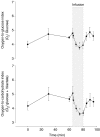Cerebral non-oxidative carbohydrate consumption in humans driven by adrenaline
- PMID: 19015195
- PMCID: PMC2670041
- DOI: 10.1113/jphysiol.2008.162073
Cerebral non-oxidative carbohydrate consumption in humans driven by adrenaline
Abstract
During brain activation, the decrease in the ratio between cerebral oxygen and carbohydrate uptake (6 O(2)/(glucose + (1)/(2) lactate); the oxygen-carbohydrate index, OCI) is attenuated by the non-selective beta-adrenergic receptor antagonist propranolol, whereas OCI remains unaffected by the beta(1)-adrenergic receptor antagonist metroprolol. These observations suggest involvement of a beta(2)-adrenergic mechanism in non-oxidative metabolism for the brain. Therefore, we evaluated the effect of adrenaline (0.08 microg kg(-1) min(-1) i.v. for 15 min) and noradrenaline (0.5, 0.1 and 0.15 microg kg(-1) min(-1) i.v. for 20 min) on the arterial to internal jugular venous concentration differences (a-v diff) of O(2), glucose and lactate in healthy humans. Adrenaline (n = 10) increased the arterial concentrations of O(2), glucose and lactate (P < 0.05) and also increased the a-v diff for glucose from 0.6 +/- 0.1 to 0.8 +/- 0.2 mM (mean +/- s.d.; P < 0.05). The a-v diff for lactate shifted from a net cerebral release to an uptake and OCI was lowered from 5.1 +/- 1.5 to 3.6 +/- 0.4 (P < 0.05) indicating an 8-fold increase in the rate of non-oxidative carbohydrate uptake during adrenaline infusion (P < 0.01). Conversely, noradrenaline (n = 8) did not affect the OCI despite an increase in the a-v diff for glucose (P < 0.05). These results support that non-oxidative carbohydrate consumption for the brain is driven by a beta(2)-adrenergic mechanism, giving neurons an abundant provision of energy when plasma adrenaline increases.
Figures



Comment in
-
Non-oxidative cerebral carbohydrate metabolism.J Physiol. 2009 Jan 15;587(1):9. doi: 10.1113/jphysiol.2008.166876. J Physiol. 2009. PMID: 19119182 Free PMC article. No abstract available.
References
-
- Abdul-Rahman A, Dahlgren N, Johansson BB, Siesjö BK. Increase in local cerebral blood flow induced by circulating adrenaline: involvement of blood–brain barrier dysfunction. Acta Physiol Scand. 1979;107:227–232. - PubMed
-
- Bergersen LH. Is lactate food for neurons? Comparison of monocarboxylate transporter subtypes in brain and muscle. Neuroscience. 2007;145:11–19. - PubMed
-
- Bogert LW, Van Lieshout JJ. Non-invasive pulsatile arterial pressure and stroke volume changes from the human finger. Exp Physiol. 2005;90:437–446. - PubMed
-
- Bouzier-Sore AK, Voisin P, Canioni P, Magistretti PJ, Pellerin L. Lactate is a preferential oxidative energy substrate over glucose for neurons in culture. J Cereb Blood Flow Metab. 2003;23:1298–1306. - PubMed
Publication types
MeSH terms
Substances
LinkOut - more resources
Full Text Sources
Miscellaneous

